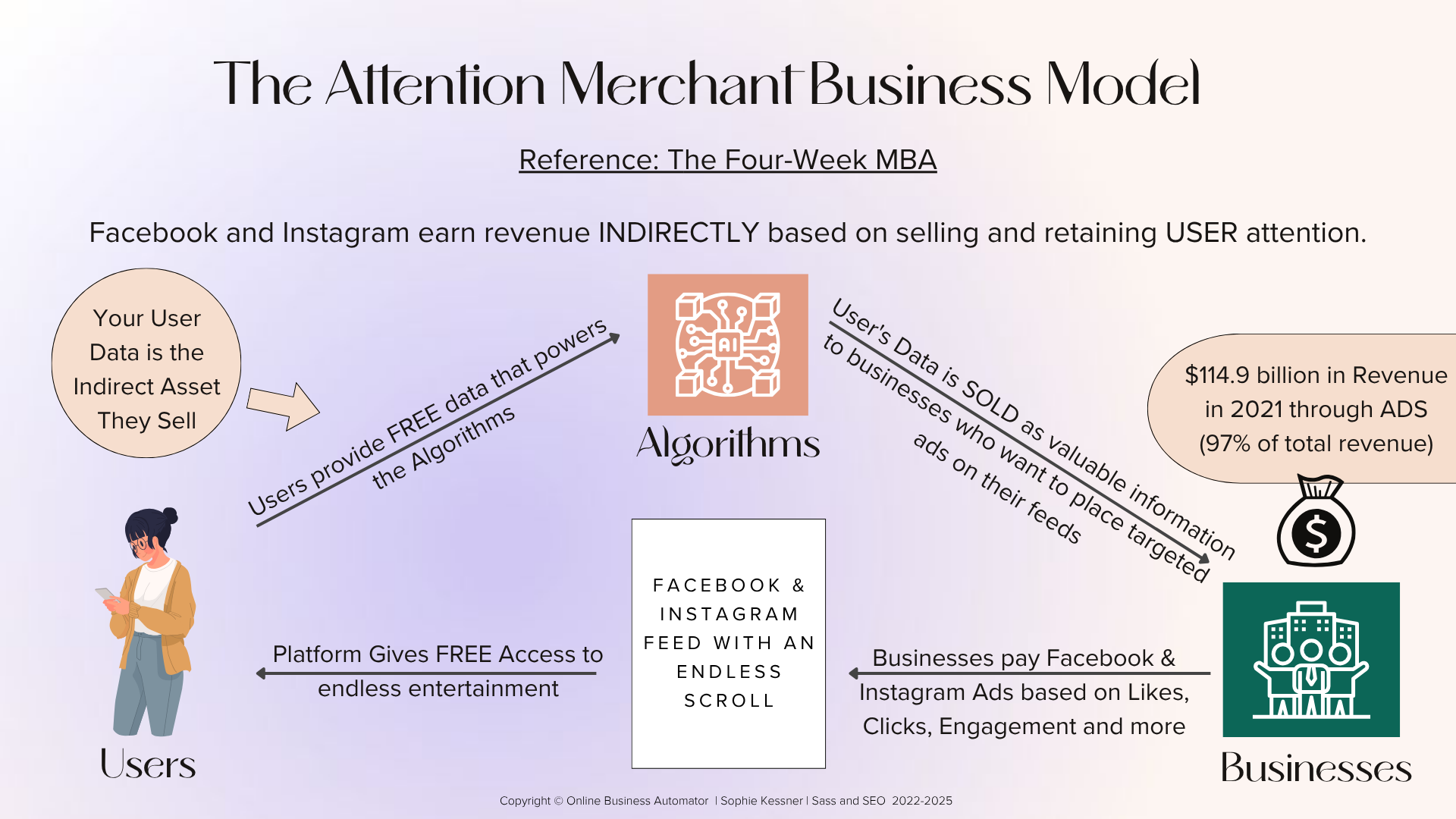
Unpacking the Attention Merchant Business Model
Social media platforms like Facebook, TikTok, and Instagram have become an undeniable part of our personal and professional lives. For business owners, especially solopreneurs and service-based entrepreneurs, understanding how these platforms operate is key. Social media companies and technology companies are structured to capture attention and convert it into economic value.
These companies generate advertising revenue by selling access to user attention, using algorithms and personalized data to maximize engagement. The company’s main goal is to maximize engagement and advertising revenue, often prioritizing profit over user well-being (Wu, 2016).
This blog explores what’s known as the Attention Merchant Business Model, how it impacts entrepreneurs, and actionable strategies to build sustainable, efficient businesses that don’t hinge entirely on social media.
How do free social media platforms like Meta, TikTok, and Instagram make money?
Social media companies offer users free profiles and free use of the platform for two main reasons:
- Collecting data on users that they use to enhance targeted paid advertising.
- Reselling advertising space to business owners who want to target specific audiences and sell their products.
For example, Meta generated approximately $44.7 billion in revenue in 2023, with over 97% coming from advertising on its platforms, including Facebook and Instagram (Meta Q4 2023 Earnings). Meta’s advertising business leverages detailed user data to enable highly targeted ads, making it the largest social media advertising platform globally (Meta Investor Relations).
TikTok’s parent company ByteDance reported an estimated $17 billion in revenue in 2023, with roughly 90% coming from advertising on TikTok (Reuters; Business of Apps). TikTok’s algorithm uses user behavior data to optimize ad delivery and maximize engagement, fueling its rapid growth in ad revenue.
Instagram alone is estimated to generate around $30 billion annually in advertising revenue, contributing significantly to Meta’s overall ad income (Statista). Instagram’s visual content and influencer ecosystem create valuable advertising opportunities for brands targeting diverse demographics.
The majority of these platforms make their money by selling advertising to business owners who want to reach you, the users.
This is why they offer free access to you—your attention and data are the products being monetized.
Additional research highlights that social media advertising revenue worldwide is expected to surpass $250 billion in 2024, emphasizing the scale and importance of this business model (eMarketer).
Understanding this model is crucial for entrepreneurs and users alike, as it reveals how social media platforms monetize user engagement and why they prioritize capturing and holding your attention.
Now that you know how social media makes money, let’s get into the bigger concept of the Attention Merchant Business Model.
What is the Attention Merchant Business Model?
The Attention Merchant Business Model, a term popularized by Tim Wu in his 2016 book The Attention Merchants, can be summarized as this: Your attention is the product, and it’s up for sale (Wu, 2016).
At its core, platforms like Facebook, Instagram, and TikTok are structured to keep you engaged for as long as possible. Here’s how it works:
- You are the user. Platforms offer free access to endless feeds of content designed to grab and hold your attention. When you pay attention to content, you are effectively exchanging your attention for access to many services and other resources offered by the platform (Wu, 2016).
- Data as the currency. While you scroll, platforms collect your behavioral and demographic data (likes, clicks, geographic details) (Zuboff, 2019).
- Businesses are the customers. That data is packaged and sold as targeted ad opportunities to businesses seeking to reach specific audiences (Goldhaber, 1997).
- Exchange attention for value. Platforms exchange attention for data and advertising opportunities, turning your consumer attention into revenue streams for themselves and their business partners (Davenport & Beck, 2001).
These platforms don’t earn revenue directly from your usage—they profit by keeping you on the platform longer so their ad space can generate returns for paying advertisers. In this environment, businesses are competing for consumer attention, which has become a key commodity in the digital economy (Goldhaber, 1997; Wu, 2016).
If you prefer to listen to an audio breakdown, I recorded a full 15+ minute podcast episode explaining how the attention merchant business model works here.
“If you’re not paying for the product, you are the product.”
– Tim Wu, The Attention Merchants: The Epic Scramble to Get Inside Our Heads (2016)
What does this mean for service providers and small businesses? It highlights the importance of understanding how social platforms operate, so you can work with them effectively while building systems to ensure your business isn’t entirely dependent on their algorithms.
Why Social Media Favors Big Budgets and Viral Posts
Algorithms on social platforms are designed to prioritize two types of content: high-stimulus, viral posts and content from users with large followings. Platforms specifically promote attention-grabbing content to attract more attention and keep users engaged. The main goal of viral and high-stimulus posts is attracting attention, as attention functions as a valuable currency in the digital landscape. The more attention a post receives, the more ads the platform can serve, which increases advertising revenue (Wu, 2016). Time spent on the platform is a key metric, and interesting content—often using hyperbolic language, appealing visuals, or sensational stories—is designed to maximize this.
1. Paid Ads Come First
Platforms like Instagram and Facebook make the majority of their revenue through advertising. Consider this staggering statistic—97% of Facebook’s revenue in 2021 came from ads (Facebook Investor Relations, 2022). To sustain this, platforms structure algorithms to favor businesses and creators who invest in paid promotions.
2. High-Stimulus, Viral Content Rules
The second priority is content that keeps users engaged the longest. Whether it’s funny memes, emotionally charged posts, or viral trends, high-stimulus content dominates because it perfectly serves the platform’s goal to maintain user attention (Wu, 2016).
For small businesses relying heavily on organic reach, this poses a problem. Thoughtful, nuanced messages often struggle to compete with flashy or provocative posts, creating a barrier between service-based entrepreneurs and their audiences.
“Meaningful organic posts can get buried under sensational content engineered for attention.”
If your posts feel like they’re fighting an uphill battle, it’s not your imagination—the stakes are designed this way (Wu, 2016).
The Double Role of Creators on Social Media
If you’re a solopreneur using social media, you’re likely playing two roles in the Attention Merchant Business Model:
- The Asset – Your activity provides platforms with valuable data about behavior patterns, preferences, and habits. Platforms analyze your interests and cognitive resources to maximize engagement, tailoring content and ads to capture your attention more effectively (Zuboff, 2019).
- The Consumer – This same data is repackaged and targeted back at you in the form of ads or promoted content.
Platforms even incentivize you to create more content by offering payment or visibility perks for frequent posting. On the surface, this might seem like a win, but the reality is, it’s designed primarily to benefit them—not you. More content means more engagement, which translates to richer data and ad revenue. The constant pressure to create can negatively impact your self-esteem and your ability to focus on meaningful work (Wu, 2016).
Attention comes in many forms—such as recognition, love, or validation—and young people, especially college students, are particularly affected by these dynamics as they navigate social media and its influence on their development and well-being (Twenge et al., 2017).
“You are both the asset and the consumer in the Attention Merchant economy.”
Recognizing this dual role is the first step in reclaiming control. Instead of feeling trapped by algorithms or pressured to post endlessly, you can start to build a more intentional strategy.
The Risks of Building a Business Solely on Social Media
For service-based business owners, it can be tempting to believe that mastering Instagram or TikTok is the key to sustainable growth. While these platforms are incredible tools, here’s why reliance on them can be risky:
- Algorithms are unpredictable. A sudden algorithm change can reduce your reach overnight, impacting your visibility and sales pipeline. Algorithms may also ignore your content, making it difficult to reach your audience even if you consistently post (Wu, 2016).
- Account vulnerabilities. Your account could be hacked, suspended, or impersonated, potentially cutting off your access to your audience.
- Content burnout. The endless cycle of needing to create, post, and engage can lead to creative exhaustion and inconsistent quality.
- Ignoring other important aspects. Relying solely on social media can lead to ignoring certain aspects of business growth, such as building an email list, networking, or developing your own website and other resources.
- Spread of fake news. Social media platforms are prone to the spread of fake news, which can harm your reputation and erode trust with your audience (Vosoughi, Roy, & Aral, 2018).
One of the most significant challenges entrepreneurs face is placing all their marketing eggs in the social media basket. Focusing only on social media may mean ignoring alternative opportunities and resources that could support your business. To build a more secure foundation, you need diversified strategies.
“The goal of social media isn’t to live there forever—it’s a step in your funnel, not the entire business.”
The Impact of Social Media on Society
Social media companies have fundamentally reshaped the way society communicates, shares information, and even perceives itself. At the heart of this transformation is the attention economy—a system where human attention is treated as a valuable, scarce resource, and social media platforms are in a constant race to capture as much of it as possible. Every scroll, like, and share is carefully engineered to maximize engagement, driving up advertising revenue for these companies (Wu, 2016).
This relentless competition for user attention has both positive and negative consequences. On the positive side, social media has made it easier than ever to connect with others, access valuable resources, and participate in global conversations. Information that once took days or weeks to circulate now spreads in seconds, democratizing knowledge and giving a voice to individuals and communities that might otherwise be ignored (Shirky, 2011).
However, the same mechanisms that make social media so powerful can also lead to information overload. In an environment where information consumes our focus at every turn, it becomes increasingly difficult to pay attention to what truly matters.
The constant barrage of attention-grabbing content can overwhelm our ability to process information, leading to a poverty of attention—a phenomenon where the abundance of media actually diminishes our capacity to focus (Simon, 1971; Davenport & Beck, 2001).
Moreover, the curated nature of social media platforms can impact self-esteem and mental health. When users are exposed to idealized images and highlight reels, it can foster unrealistic expectations and social comparison. The drive to maximize engagement often exacerbates these effects (Twenge et al., 2017).
Building a Sustainable Business Beyond Social Media
The good news? You don’t have to choose between being on social media or abandoning it entirely. Social media can be a stepping stone toward systems that support long-term growth and consistency.
As our economic system shifts from a material-based economy to a digital economy, attention has become a central resource and currency. In this new landscape, attention economics is now a key consideration for building a sustainable business (Goldhaber, 1997; Wu, 2016).
1. Focus on Building Your Email List
An email list is one of the most powerful tools for solopreneurs. Unlike social platforms, where visibility depends on competing with viral or paid content, email gives you direct access to your audience.
Why it’s valuable:
- No algorithm to battle
- Permission-based reach
- Clear and direct communication
2. Leverage SEO and Search-Based Platforms
While social platforms rely on capturing attention, SEO (Search Engine Optimization) works by meeting people’s needs at the moment they’re searching for solutions. Platforms like Google, YouTube, and Pinterest prioritize content intended to answer specific questions. Recent developments in artificial intelligence and the rise of AI-generated content are changing how people discover information online. Ongoing research in this area is helping businesses adapt to new trends and technologies (Cheng et al., 2023).
Example:
A client searches “best time-saving hacks for solopreneurs” on Google, and they find your blog sharing practical tips and solutions—that’s SEO in action.
SEO-Based Content: For those looking to enhance their strategy, check out these top content optimization tools recommended by SEO experts for improved search rankings and engagement.
- Long-term visibility
- Reaches highly motivated audiences
- Less reliant on trends or algorithms
The key is balancing attention-driven platforms with intent-based channels to create a full-stack marketing strategy.
3. Streamline Business Operations with Automation
One way to minimize reliance on social media is by leveraging automation in your backend systems. Advances in computer science have enabled businesses to exchange attention for greater efficiency through automation, allowing resources that would be spent on manual tasks to be redirected toward higher-value activities. Tools such as automated onboarding, CRM software, and analytics dashboards help you scale your business without increasing your manual workload (Davenport & Beck, 2001).
Example Tools to Explore:
- Email marketing software like Flodesk
- Workflow tools like HoneyBook or Dubsado
- Analytics platforms for tracking growth
“Automation empowers you to save time, deliver seamless client experiences, and scale without burnout.”
4. Use Social Media Intentionally
Instead of viewing social media as an all-or-nothing game, treat it as one part of your ecosystem. Social media serves as a medium for connecting with audiences and focuses on providing many services to keep users engaged. The goal is to bring people off the platform—into other spaces like your email list, blog, or online courses.
Strategies to Explore:
- Add lead magnets to your Instagram bio
- Create content that drives traffic to a blog or YouTube channel
- Run ads strategically when ready
This approach ensures that your business presence on social media is a choice, not an obligation.
Final Thoughts
The Attention Merchant Business Model shows us the importance of balancing short-term strategies with sustainable ones. Social media may be a powerful tool for engagement and visibility, but it’s critical to build a business that doesn’t crumble if the algorithm shifts or platforms evolve.
By focusing on email marketing, SEO, automation, and intentional content strategy, you can create a business that’s not just stable but ready to thrive.
Summary of Citations
- Cheng, G., et al. (2023). Artificial Intelligence and Search Engine Optimization: Trends and Implications. Journal of Digital Marketing.
- Davenport, T., & Beck, J. (2001). The Attention Economy: Understanding the New Currency of Business. Harvard Business School Press.
- Facebook Investor Relations. (2022). Facebook Annual Report 2021. Meta Platforms, Inc.
- Goldhaber, M. H. (1997). The Attention Economy and the Net. First Monday, 2(4).
- Shirky, C. (2011). Cognitive Surplus: Creativity and Generosity in a Connected Age. Penguin Press.
- Simon, H. A. (1971). Designing Organizations for an Information-Rich World. Johns Hopkins Press.
- Twenge, J. M., et al. (2017). Increases in Depressive Symptoms, Suicide-Related Outcomes, and Suicide Rates Among U.S. Adolescents After 2010 and Links to Increased New Media Screen Time. Clinical Psychological Science.
- Vosoughi, S., Roy, D., & Aral, S. (2018). The Spread of True and False News Online. Science, 359(6380), 1146-1151.
- Wu, T. (2016). The Attention Merchants: The Epic Scramble to Get Inside Our Heads. Knopf.
- Zuboff, S. (2019). The Age of Surveillance Capitalism. PublicAffairs.





